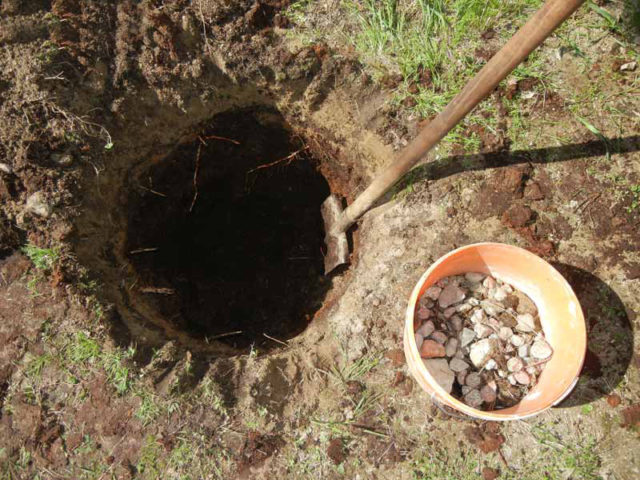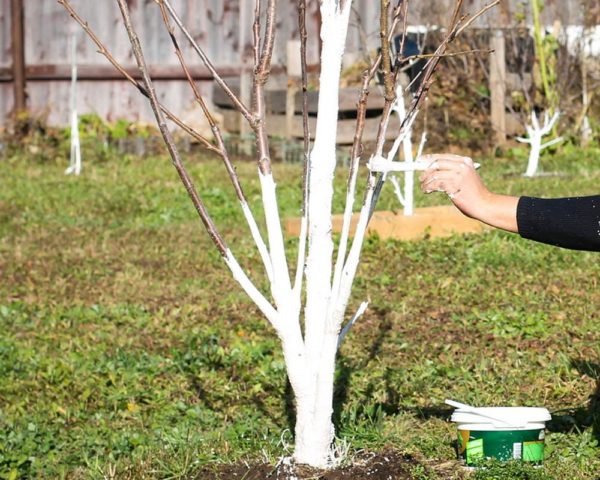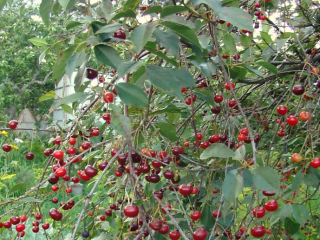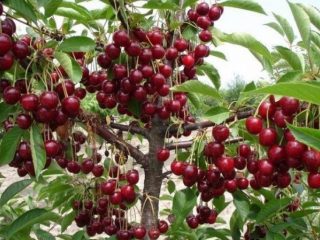Content
- 1 When is it better to replant cherries: in autumn or spring?
- 2 Timing for replanting cherries in autumn
- 3 Selecting a location and preparing a planting hole
- 4 Rules for transplanting cherries to a new place in the fall
- 5 Autumn care of cherries after transplantation
- 6 Professional advice on replanting cherries in the fall
- 7 Conclusion
For one reason or another, the place initially chosen for landing may turn out to be unsuccessful. In this case, the tree will grow poorly, bear fruit poorly, and sometimes the harvest may not be seen at all. The situation can only be saved by replanting the cherry tree in the fall or spring to another, more suitable place.
When is it better to replant cherries: in autumn or spring?
The growing season of cherries begins quite early, especially in early varieties. Therefore, in the spring there is a very high risk of not having time to replant the tree while it is still dormant. Transplanting cherries that have entered the growing season will greatly delay their rehabilitation; the tree in the new location will take a long time to take root, later bloom, and stop bearing fruit. If the trees have already entered the growing season, then it is better to postpone replanting until the fall.

If the tree has entered the growing season, it cannot be replanted.
Late varieties of cherries wake up after hibernation with a noticeable lag behind the early ones. Therefore, they are replanted in the spring. Also, spring transplantation is preferable in cold regions where winter begins early. In the fall, there is a high chance that the transplanted tree will not have time to take root in its new location and will die from frost. If the actual timing of the arrival of winter is close to the calendar, then autumn transplantation looks preferable for the following reasons:
- Over the winter, the plant will strengthen its immunity.
- Trees transplanted in autumn begin to bloom and bear fruit earlier.
- Cherry adapts faster to a new place.
- The likelihood of developing diseases and pests is extremely low.
The older the cherry tree is, the worse it tolerates transplantation. Trees older than 10 years are replanted only in exceptional cases, and the likelihood of their death is very high.
Steppe and felt varieties of cherries tolerate replanting very poorly, especially in adulthood. Even if the plants do not die after the work, their recovery may take a very long time.

Felt cherry does not tolerate transplantation very well
Timing for replanting cherries in autumn
When transplanting cherries to a new place in the fall, you need to focus not on the calendar date, but on local climatic conditions, based on which the tree must be planted no later than a month before the onset of cold weather. In the Moscow region, in the middle zone and central Russia, transplantation is carried out in the first half of October. In the southern regions this can be done later, at the end of October or beginning of November.But in Siberia and the Urals, it is better to avoid replanting cherries in the fall; the best time to carry out work in these regions is spring.
Selecting a location and preparing a planting hole
A poor planting location may cause the cherry tree to not bear fruit at all. If the location was initially chosen incorrectly, then all these factors must be taken into account when replanting. There are several main points here:
- The best place for cherries is on the south side of a fence or low building.
- The place should not be in the shade of large trees or large structures.
- Groundwater in the place where cherries are planted should lie at a depth of 2 m or lower.
- The soil on the site should be loose, breathable, with a close to neutral acidity level.
- There should not be beds with nightshade crops (peppers, tomatoes) next to the cherries, since they have the same diseases.

Planting holes must be prepared in advance
When replanting cherries, it is necessary to dig planting holes in advance, the size of which should be commensurate with the root system of the transplanted tree. They add compost, a few tablespoons of potassium and phosphorus fertilizer, and wood ash. The hole needs to be spilled with water so that the fertilizer is partially dissolved and the soil settles a little.
A short video on the topic of choosing the right place to plant cherries can be viewed at the link:
Rules for transplanting cherries to a new place in the fall
It is more convenient to transplant a cherry tree with two people, and if the tree is mature, then more helpers may be needed.The older the tree, the more powerful its root system, and accordingly, the larger the lump of earth on the roots should be.
Features of transplanting young cherries in autumn
At an early age, cherries, as a rule, tolerate transplantation to a new location quite well. When removing a young seedling, it is not always possible to preserve the earth ball, especially if the soil is loose and not moist enough. If the roots of a tree have dried out, then before planting it is advisable to soak them for several hours, completely immersing the roots in water.

After transplanting a young cherry seedling, you need to create a watering zone
Be sure to do a thorough inspection of the root system. If some roots show signs of rot, they need to be cut off. To prevent the cut from causing infection, it is cauterized with a strong solution of potassium permanganate.
Transplanting an adult cherry tree to a new location in the fall
Transplanting an adult cherry tree to a new location is a simple but labor-intensive procedure. It is produced in several stages:
- The tree trunk circle is shed generously with water so that the earthen lump, if possible, does not crumble.
- The tree is dug in a circle at a distance of approximately 0.75 m from the trunk and to a depth of at least 0.6 m.
- The cherry, along with a lump of earth, is carefully removed from the hole. Due to the significant weight, it is better to do this with several assistants.
- Roots chopped off and damaged during the extraction process are cauterized with potassium permanganate. If they come across rotten ones, they are cut off. Sections are also treated with potassium permanganate.
- The tree is moved to a new location on a piece of tarpaulin or on a garden wheelbarrow.
- On site, check whether the dug planting hole matches the size of the earthen ball on the roots. If necessary, the pit is expanded and deepened.
- Place the cherry tree in the planting hole.The lump should rise slightly above the surface of the earth.
- All voids are filled with earth and compacted well.
- An earthen roller is formed along the border of the root zone as the border of the irrigation zone.
- Water the tree abundantly.
- The tree trunk circle is mulched with humus, straw or sawdust.

All voids must be filled with earth and compacted.
Is it possible to replant bush and felt cherries in the fall?
It is not recommended to touch both of these varieties of cherries after planting. Replanting these varieties in the fall is allowed as a last resort and only on condition that the age of the bushes does not exceed 4-5 years. In addition, the following requirements must be met:
- The bush should be at rest, there should be no leaves on it.
- There should be at least 1 month left before frost.
- It is important to replant as carefully as possible and only with a clod of earth.
Transplanting a felt cherry tree to a new place in the fall is not difficult.
Autumn care of cherries after transplantation
After transplanting the cherries, all necessary measures are taken to prepare for winter. Young seedlings are covered with a metal mesh and spruce branches, this will protect them from frost and hares. In mature trees, be sure to whiten the trunk and lower skeletal branches to a height of about 1.5 m. This will protect the tree bark from sunburn in the spring.

Whitewashing cherries should be done not only in autumn, but also in spring
After the first frost, the trees are sprayed with a urea solution, diluting 30 g of the substance in a bucket of water. This will not only increase the winter hardiness of the trees, but will also kill the larvae of insect pests overwintering in the folds and cracks of the bark.
Professional advice on replanting cherries in the fall
To avoid unnecessary problems when replanting cherries in the fall, professional gardeners advise adhering to the following recommendations:
- When choosing a landing site, it is advisable to immediately take into account all possible scenarios. If in the future construction, expansion or other measures are planned on the site, the consequence of which may be the need for subsequent replanting, this must be taken into account and not plant cherries in this place.
- Replanting a cherry tree is a painful procedure, and the older the tree, the less likely it is to be successful.
- Before replanting, it is advisable to prune the tree, removing excess shoots, standard growth, as well as all dry and damaged branches.
- It is not advisable to replant cherries in the fall when it rains. Contrary to popular belief, excess humidity does not promote better survival.
- You should always try to keep the earthen ball on the roots as much as possible. The more intact and larger it is, the greater the likelihood of success during transplantation.

Dried cherries are the result of improper transplantation
A tree transplanted late will either freeze in the winter or die in the spring due to the so-called “biological drought,” when the root system, which has not taken root in the new place, simply cannot cope with the supply of water and nutrients to the tree that entered the growing season early.
Conclusion
Transplanting a cherry tree in the fall can give new life to the tree, but this procedure is quite risky. Young trees will most likely tolerate it well if you follow all the rules and deadlines, but with adult specimens everything is much more complicated. In this case, you need to use common sense and take into account the age of the tree and the associated risks. Perhaps it would be more appropriate to plant a young seedling in the fall than to spend effort and money on moving and rehabilitating a specimen of “pre-retirement” age.








